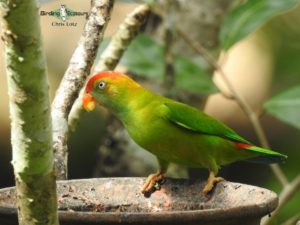Go to Sri Lanka Endemics & Winter Specials bird tour page | Asian bird tours | Asian trip reports | All our birding tours
DOWNLOAD TRIP REPORT
13th – 26th JANUARY 2019
Sri Lanka Hanging Parrot
Overview
Sri Lanka is always incredible, but we enjoy doing our annual trip in January, as Blue Whale is tough to miss during that month and wintering birds such as Indian Pitta, Pied Thrush, and Kashmir Flycatcher can be seen along with the island’s 34 endemics (that are present year-round). The 2019 trip did not disappoint, and we did well with the endemics, wintering birds, mammals (which also included Leopard), and a lot of reptiles and other taxa.
This ended up being a private tour for three Brazilian bird photographers, so we were able to accommodate the pace they wanted to keep. The below is a day-by-day account of the trip, followed by bird, mammal, and reptile lists. E-bird lists are available for virtually all the birding we did; to view these, kindly go to the public e-bird profile of Chris Lotz (Birding Ecotours) and check the lists corresponding to the tour dates.
Detailed Report
Day 1, 13th January 2019: Arrival into Katunayake Airport and transfer to Negombo
The three trip participants arrived today at the Bandaranaike International Airport in Katunayake, serving Sri Lanka’s capital Colombo, and opted to rest at our comfortable beach hotel in Negombo until the next morning.
Day 2, 14th January 2019: Negombo to Kitulgala
We departed at 8:30 a.m. after a leisurely breakfast, giving adequate time for everyone to get a good night’s rest after long flights from the other side of the world. We made frequent stops along the way to Kitulgala, as everything was new and exciting (two of the trip participants had never been to Asia before). The first bird we stopped for was Asian Openbill, but quite a number of other birds were also present at the same place, including Little Cormorant, Red-wattled Lapwing, and the beautiful White-throated Kingfisher, not to mention a massive Common Water Monitor.
A bit further on we stopped at a rice paddy and saw all the possible Egret species, Purple Heron, Indian Pond Heron, Crested Honey Buzzard, a juvenile Changeable Hawk-Eagle, our first of many Brahminy Kites, Blue-tailed Bee-eater, Western Yellow Wagtail, and more.
The best stop of the day (until getting to our lodging) was our opportunity to look at a day-roosting Indian Scops Owl. Another highlight was seeing our first Barbets, two of them endemic (Crimson-fronted and Yellow-fronted) and one more widespread (Brown-headed). We also found our first Black-hooded Oriole, and Joao found (and photographed) White-browed Fantail, while the rest of us enjoyed our first of many Purple-rumped Sunbirds. At the same site was our first of many small flocks of Yellow-billed Babblers.
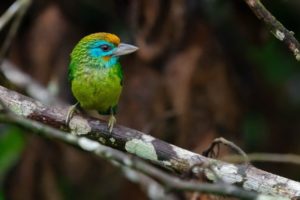
We eventually arrived at the Kitulgala Rest House, where we were to spend the next two nights. What an amazing setting overlooking the Kelani River, where “The Bridge on the River Kwai” was filmed!
We immediately sat down for a late lunch but had to keep jumping up to look at new trip birds between courses. So many birds put in appearances, such as Black Eagle, White-bellied Sea Eagle, Indian Cormorant, the endemic Sri Lanka Green Pigeon, Green Imperial Pigeon, Asian Koel, Indian Swiftlet, the endemic Sri Lanka Grey Hornbill, and Brown-capped Pygmy Woodpecker.
One of the great things about the place at which we were staying was the Sri Lanka Hanging Parrots that came down to the feeder, treating us to really close-up views. The endemic Layard’s Parakeet as well as Alexandrine and Rose-ringed Parakeets were much in evidence. A Ruddy Mongoose also came in to try and get its share of our food, and Indian Palm Squirrels with their beautiful stripy backs were always entertaining, sometimes running along power lines. Here we enjoyed our first Bar-winged Flycatcher-shrike, White-bellied Drongo, and a pair of Indian Jungle Crows that were nice to see after looking at thousands of the abundant (but very entertaining) House Crows along the way. Our first Bulbuls, Square-tailed and the ubiquitous Red-vented, showed well. Common Tailorbird, Oriental White-eye, and Oriental Magpie-Robin were some of the common, widespread Asian species that were also firsts for this tour today.
A beautiful Changeable Hawk-Eagle gave close-up views within the lodge grounds. At one point it hung upside down, and we changed its name to “Bat Eagle”.
We enjoyed looking at the subtle distinguishing features of Asian Brown versus Brown-breasted Flycatchers, species we would become very familiar with in the coming days.
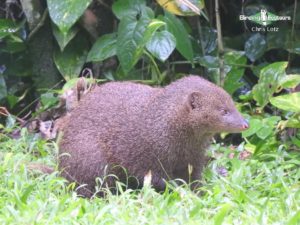
Day 3, 15th January 2019: Full day in Kitulgala
After a 6:30 a.m. breakfast we crossed the river by boat and then did an exciting trail, first through a birdy village and then into the forest proper. We were pleased to find a mixed flock of the endemic Orange-billed Babbler and the more common and widespread Yellow-billed Babbler. We also saw an attractive little Dark-fronted Babbler and later the endemic Brown-capped Babbler. We also found a couple of Malabar Trogons, but not as well as we would have liked. Our first Asian Palm Swifts winged their way over us, and we were pleased to see Sri Lanka Swallows as well. Marshall’s Iora was a really pleasant surprise, along with Common Iora a bit later.
On the way back we got amazingly close views of a pair of endemic, beautiful Spot-winged Thrushes that crossed the road one by one.
An afternoon walk after a delicious lunch was very productive, with the endemic Black-capped Bulbul, Yellow-browed Bulbul, and the very common Square-tailed Bulbul, Southern (Greater) Coucal, Sri Lanka Junglefowl, Shikra, and a gorgeous Common Emerald Dove uncharacteristically giving great views as it walked through a small tea plantation. A flock of Small Minivets showed well, and some group members had already seen Orange Minivets earlier today. Sri Lanka Grey Hornbills were everywhere, and we found their antics and laughing as well as bleating calls very entertaining. Lesser Yellownape and the endemic Red-backed Flameback (now that it has been split from Black-rumped Flameback) were two exotic woodpeckers that we managed to find.
The star highlight of the afternoon was a stunning Chestnut-backed Owlet. What a bird, and yet another endemic! By the end of today we had actually found almost a third of Sri Lanka’s 34 endemics!
On the way back to the car we found a male of the beautiful white form of Indian Paradise Flycatcher with ridiculously long tail streamers – what a bird! A nearby female Tickell’s Blue Flycatcher was also nice to see.
Sri Lanka’s smallest bird, Pale-billed Flowerpecker, as well as the more brightly-colored, endemic Legge’s Flowerpecker were also seen a couple of times today. A small flock of Black-throated Munias put in an appearance too.
A Giant Wood Spider and many butterfly species were also excellent to see during the course of the day.
Day 4, 16th January 2019: Kitulgala to Sinharaja Forest Reserve
We had another 6:30 a.m. breakfast, during which we managed to scope a Grizzled Giant Squirrel (what an impressive animal!) across the river. We then took a fun ride in tuk-tuks up and up to an amazing site at higher altitude, where practically the first birds we saw were gorgeous Sri Lanka Blue Magpies. Soon thereafter a pair of sometimes tricky-to-find White-faced Starlings came to their nest! This is a very localized endemic and quite an interesting-looking bird (although certainly not dazzling). Sri Lanka Drongos were scoped. We also heard Sri Lanka Whistling Thrush but sadly were unable to see it. The same happened with Ashy-headed Laughingthrush as well as Green-billed Coucal, so we’d have to find these three endemics later in the trip. We did get our best views yet of the fabulous Red-backed Flameback, though – what a superb woodpecker! Just as we were about to leave Banded Bay Cuckoo started calling incessantly, and we managed to get it in the scope.
Then we finally went back to the lodge to quickly pack up, check out, and then drive to the next place where we were going to spend three nights, the Blue Magpie Lodge right next to Sri Lanka’s largest intact lowland forest area, the amazing Sinharaja Forest Reserve, a national park that is also a UNESCO World Heritage Site. Exciting days ahead!
When we arrived at the lodge we immediately sat down for lunch. It rained while we had lunch, but there were many birds in evidence as we looked over to the pond below us. We actually amassed 35 bird species in less than two hours within the lodge grounds during and after lunch, while it rained most of the time! A pair of White-breasted Waterhens with a jet-black chick following them around were quite entertaining. Sri Lanka Hanging Parrots and Plum-headed Parakeets flew over. White-throated Kingfisher provided a splash of color, as did Blue-tailed Bee-eaters. White-rumped Munias put in an appearance, and we had further close-up views of Common Emerald Doves. And a couple of Blyth’s Reed Warblers skulked around.
Non-avian highlights included the most massive Common Water Monitor and lots of Indian Palm Squirrels.
After lunch, from their balcony, the group enjoyed getting photos of a pair of Orange Minivets, a female Black-headed Cuckooshrike, and a nearby Yellow-fronted Barbet. A rufous-morph Indian Paradise Flycatcher with its almost foot-long tail was great to compare with the white morph we had seen the previous afternoon. Both Southern Hill Mynas and the endemic Sri Lanka Hill Mynas were at different times “put into the scope”, as was Golden-fronted Leafbird. Brown Shrike watched from a prominent perch for things to eat. Crested Treeswifts also perched on bare branches and flew around, providing good views.
The group also saw a Common Green Forest Lizard eating a grasshopper.
After the post-lunch rest, during which the group photographed birds from the balcony, we were just about to go for a stroll near the lodge when a local guide called us to say he had found a Serendib Scops Owl, possibly the most sought-after bird of Sri Lanka, at its roost! So we quickly took a jeep to the Sinharaja Forest Reserve and had to walk up a really steep trail, but, wow, what a reward awaited us! This is a recently-described Sri Lanka endemic with a population thought to number less than 250 individuals! The Serendib Scops Owl is a peculiar, tiny owl with “false” ear tufts unlike the “true” ear tufts of other scops/screech owl species. There were also a few Purple-faced Leaf Monkeys around.
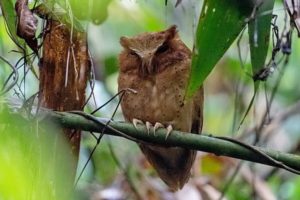
After enjoying this wonderful bird we went back to the lodge for an hour-and-a-half break before dinner. What a spectacular day, despite the fact that three hours of it were spent driving between sites, but the birding we did tended to be pretty relaxing, except for the scramble up to the owl.
Day 5, 17th January 2019: Kudawa section of the Sinharaja Forest Reserve
Starting with coffee at the Blue Magpie Lodge at 5:45 a.m. we heard Chestnut-backed Owlet before journeying to the park, where we had breakfast at the entrance gate, looking and listening for birds. One of the first birds we heard (and glimpsed) as we ascended the trail (we spent about six hours walking this trail) was Sri Lanka Thrush, along with its easier-to-see relative, Spot-winged Thrush. We heard Sri Lanka Spurfowl, but didn’t worry too much since we were to go to a stakeout for this species the next morning, and were accompanied by a tame Sri Lanka Junglefowl for a while.
We actually heard Serendib Scops Owl on the way and went to the day-time roost of Sri Lanka Frogmouth (a female); the latter was voted the bird of the day. A pair of White-faced Starlings suddenly appeared at the frogmouth site. We actually encountered this species quite a few times during this tour, although sometimes it proves tricky.
A couple of Malabar Trogons showed briefly, and the magnificent Crimson-backed Woodpecker paid us an all-too-quick visit before flying far away and drumming/calling extremely loudly. Black-naped Monarch and its more extravagant cousin, Indian Paradise Flycatcher, were around in small numbers during the walk.
A couple of mixed flocks were, as always, extremely exciting! Ashy-headed Laughingthrushes showed very well, as did a cute little pair of Sri Lanka White-eyes. Sri Lanka Scimitar Babbler did not show very well (but we saw this species much better later in the trip). Red-faced Malkoha called once or twice, but we would have to wait until the next day to lay eyes on this beautiful species.
Arriving back at the jeep after our long walk we were rewarded with some really interesting reptiles in the form of Green Pit Viper and a bright green Whistling Lizard, which, however, sat very quietly and didn’t whistle for us. Soon after we started our drive back to the lodge we stopped for a humongous, gorgeous Atlas Moth.
We were all tired after the long walk, so after lunch we only did some relaxed birding around our lodge and the adjacent village. A pair of Black-headed Cuckooshrikes circling around the lodge and landing in some of the big trees at various places within the lodge grounds were fun to see, although they didn’t ever pose long enough in one place for photos. Blyth’s Reed Warbler popped out a couple of times and made itself more visible than usual for this skulking species. We scoped Golden-fronted Leafbird sitting atop a tall palm tree. Legge’s Flowerpeckers and Plum-headed Parakeet flybys also helped to keep us entertained.
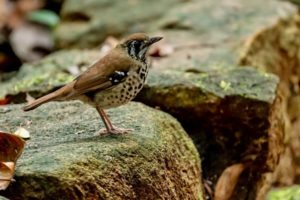
Day 6, 18th January 2019: Sri Lanka Spurfowl stakeout and other sites around Kudawa
We met for coffee at 5:15 a.m. before our half-an-hour jeep journey to the Sri Lanka Spurfowl site. We arrived just before light and were rewarded with great views of some usually-tricky endemics. This is an amazing stakeout, as a pair of the usually really difficult Sri Lanka Spurfowl come in and walk around right in front of people here. Several Sri Lanka Junglefowls do the same thing, and Slaty-legged Crake is also easy to see here. Green-billed Coucal did not cooperate as well as usual, possibly because it was scared of the immature Crested Serpent Eagle perched nearby, so we only heard the coucal calling on a nearby hill and had to wait until later in the trip to get visuals of this species. Ashy-crowned Laughingthrushes, Orange-billed Babblers, and many other star birds did come in close, Sri Lanka Scimitar Babbler also lurked around, and a gaudy Sri Lanka Blue Magpie showed up for a little while. Spot-winged Thrushes came really close to us, and Brown Shrike was also present. Mammal-wise we added a new species to our list, Dusky-striped Squirrel.
We arrived back at the lodge in time for a long rest in the heat of the day, but while we were waiting for lunch we enjoyed some of the birds that lived around the lodge. The most popular of these must have been the orange form of Indian Paradise Flycatcher with its mega-long tail, the ever-present White-throated Kingfisher, and Golden-fronted Leafbird. A magnificent adult Crested Serpent Eagle gave us a good flight show.
In the afternoon we did some birding along the road in the Kudawa area. We managed to see Green-billed Coucal, but not very well. Apart from that we enjoyed a good number of bird species we had already seen earlier during the trip, along with a couple of new lizards. One of them was Sri Lankan Kangaroo Lizard, a small lizard with kangaroo-like, big hind legs and smaller front legs. The other one was an Eastern Garden Lizard.
Day 7, 19th January 2019: Kudawa section of Sinharaja Forest Reserve, transfer to Mirissa
This proved to be yet another spectacular day! Soon after we arrived in the reserve we located a large mixed flock. After about half an hour of enjoying species we’d already seen before we located three Red-faced Malkohas! These beautiful endemics put on quite a show, as two of them decided to fly right towards us, landing in a tree just in front of us. They didn’t stay long but did provide reasonable photo opportunities. A pair of Green-billed Coucals also put on quite a show, and White-faced Starlings showed yet again.
We later found another really superb mixed flock that contained Lesser Yellownape, another Green-billed Coucal that Joao spotted right next to the trail, Sri Lanka Scimitar Babbler, Sri Lanka Blue Magpie, and many other star birds, albeit ones we’d seen before. We did get views, however, of a pair of Black-naped Monarchs that had previously only given us glimpses. We also saw Large-billed Leaf Warbler, but although we had poor views at least we heard it calling to clinch the ID. The star birds, however, were three Velvet-fronted Nuthatches, a species we hadn’t seen yet.
Carnivorous pitcher plants were fascinating to see.
On the rough jeep drive back to our hotel for our final lunch there before departing for the south coast at Mirissa we found our first Indian Peafowl, a ubiquitous bird during the second half of our itinerary, though.
During the three-hour journey to Mirissa we saw some nice roadside birds such as a Black-headed Ibis, Painted Stork, and White-bellied Sea Eagle.
Day 8, 20th January 2019: Mirissa pelagic, transfer to Tissamaharama, birding on the way
We started the day with a spectacular pelagic trip looking for Blue Whales, which we saw well! In addition we also enjoyed seeing lots of Spinner Dolphins on the way, the small/young ones leaping out of the water and spinning playfully. We also approached a pair of Green Turtles and saw a Sailfish as well as good numbers of Flying Fish. Birds were scarce, but we did add some tern species to our growing trip list.
After the boat trip we stopped for a delicious, spicy lunch before driving for a couple of hours to the Hambantota salt pans, where we found a lot of shorebirds (waders). These included Eurasian Spoonbill, Black-headed Ibis, many Black-winged Stilts, Grey (Black-bellied) Plover, Lesser Sand Plover, Curlew Sandpiper, Little Stint, Common Redshank, Common Greenshank, and Marsh Sandpiper. There were several Tern species present, namely Caspian and Little on opposite ends of the size spectrum and the in-between-sized Gull-billed, Whiskered, and White-winged. We’d seen Greater Crested Tern on the pelagic, so it was a good day for terns. We also found our first Striated Heron here as well as a close-up juvenile Shikra.
The last stop of the day was extremely exciting from a birding point of view, and we found 57 bird species within the time of two hours. The site was Debarawewa Lake, but we first had a few non-waterbirds to see in the area. Two of the first species we found were superb owls, Jungle Owlet and Brown Fish Owl. While looking for these we found Jerdon’s Leafbird, Brown-headed Barbet, White-browed Robin, Indian Robin, and a lovely Gray-breasted Prinia that we scoped as it sang from atop a tree.
The marshy areas were full of birds, including Yellow Bittern, Black Bittern, Lesser Whistling Duck, Spot-billed Pelican, loads of Grey-headed Swamphens, Eurasian Moorhen, Painted Stork, Asian Openbill, and large numbers of Indian Cormorants flying over in flocks to roost sites just before it was getting dark. A lot of Rose-ringed Parakeets also started coming in to roost toward the end of our birding session. Chris saw Coppersmith Barbet and a fabulous White-naped Woodpecker. A beautiful White-bellied Sea Eagle flew past at one point.
Indian Flying Foxes, Southern Gray Langur, and huge Muggers (Marsh Crocodiles) were three of the non-avian species we enjoyed.
As it was starting to get dark we checked into our comfortable hotel in Tissamaharama, where we’d spend the next two nights, poised well to tackle the famous Yala National Park the next day.
Day 9, 21st January 2019: a full day in Yala National Park
We spent an entire day inside the beautiful Yala National Park, which unfortunately is by no means a “best kept secret” and is infamous for becoming crowded with tourists looking for the Sri Lankan subspecies of Leopard. This was our main target today, and while this is arguably the best place on the planet for this beautiful cat, Leopards are always elusive. We got our first sighting of one in the mid-afternoon as it quickly ran across the road in front of us and vanished! We had to wait perhaps an hour and a half more before jeeps started rushing past us; obviously there had been a sighting of another Leopard further on. So we followed, only to get stuck behind a line of vehicles. We did have an open area to the right of us (Yala National Park is dry, but densely wooded with lots of thickets), and we basically just hoped the Leopard would move in the right direction and move into the open area. We didn’t feel the chances were very high, but after perhaps 15 minutes of waiting we saw a Black-naped Hare running for its life (literally, I guess). We struggled to contain our excitement, and suddenly Ana spotted the Sri Lankan Leopard at the edge of the open area. It then came into view for all of us and sat down like a dog, allowing great views and photos. After a while it moved off, providing some further good views. What a relief to finally get a proper sighting of this magnificent animal, only 40 minutes before we were due out of the park at 6:00 p.m.!
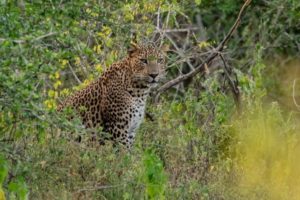
During the course of the day we also saw Asian Elephant, wild Water Buffalo, the pretty Spotted Dear, Sambar, Wild Boar (one pair of these was accompanied by a bunch of tiny piglets), Southern Grey Langur, quite a few Common Indian Monitors, a couple of Muggers (Marsh Crocodiles), and other animals.
We also recorded 93 bird species within the park, but since we were focusing on finding Leopard, we didn’t take very much time to get everyone onto all of them. We also knew that the next day we’d have adequate time for finding a lot of the arid-zone birds. I certainly don’t want to downplay the birding, though; in reality it was actually spectacular! We enjoyed close-up views of two dazzling Bee-eaters, Green (abundant) and Chestnut-headed. We also enjoyed seeing our first Yellow-wattled Lapwing among the more common Red-wattled Lapwing. We also added some more shorebirds to our list, such as Common Sandpiper, Wood Sandpiper, and a very nice Pacific Golden Plover. A spectacular but ugly Lesser Adjutant and its more beautiful cousins Painted Stork and Asian Openbill were great to see. Grey-headed Fish Eagle also showed up.
Lunch on the beach (this amazing park is indeed right on the coast) allowed us to see a few good birds, such as a lot of Purple Sunbirds, a couple of Plain Prinias, etc.
Blyth’s Pipit, Paddyfield Pipit and Jerdon’s Bush Lark were great to see even though being LBJs (Little Brown Jobs). More strikingly attractive were Ashy-crowned Sparrow-Larks. We enjoyed Streaked Weavers (and we saw the impressive nests of Baya Weaver), two Munia species, Tricolored and Scaly-breasted, and several Malabar Pied Hornbills.
Probably the bird of the day, because it was the only Sri Lanka endemic, was Sri Lanka Woodshrike, which we saw well. We also added another beautiful green pigeon to our list, Orange-breasted Green Pigeon, and were really pleased to see another pair of Brown Fish Owls on a branch pretty much right above us – we had close-up views! Yellow-crowned Woodpecker also gave excellent views. A flock of Brahminy Starlings and several flocks of Rosy Starlings were around, and there were lots of Indian Robins and a few White-browed Fantails along with some Indian Paradise Flycatchers, the latter including a dazzling white form with its unbelievably long tail. And Eurasian Hoopoe is always a real treat!
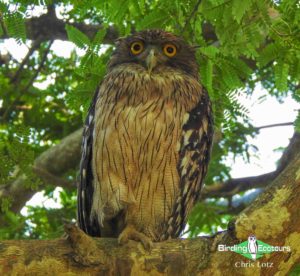
Day 10, 22nd January 2019: Udawalawe National Park
The day started with an Indian Pitta and many other birds near our hotel. A male and a female Asian Koel as well as a pair of Indian Silverbills showed very well, as did a lot of other birds not listed here because they were seen earlier in the trip and thus have already been mentioned.
We then went to Tissa Lake to witness the large roost of Indian Flying Foxes in large trees shared with breeding shorebirds such as Grey Heron and cormorants. We were very pleased to find Cinnamon Bittern, three Cotton Pygmy Geese, Great Cormorant, Common Kingfisher, Zitting Cisticola, and other new trip birds. Our closest-yet encounter with beautiful Pheasant-tailed Jacanas was a delight to the entire group.
We then embarked on the 1.5-hour drive to our lodge just outside of Udawalawe National Park and arrived just in time for lunch. An afternoon jeep outing into the park was lots of fun and very rewarding, with quite a number of new birds being added to our burgeoning list. We enjoyed several Prinia species in the form of Plain, Jungle, Grey-breasted and Ashy. Yellow-eyed Babblers and four Grey-breasted Cuckoos were two of the targets we managed to find without problems. A good number of Orange-breasted Green Pigeons showed extremely well, and a few Indian Rollers were also seen. A couple of large flocks of Rosy Starlings were around too. In addition we saw a beautiful pair of White-bellied Sea Eagles, a close-up Changeable Hawk-Eagle, and quite a number of waterbirds, including a couple of new ones like Little Ringed Plover and Green Sandpiper.
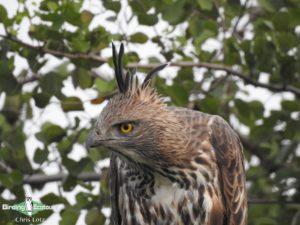
Day 11, 23rd January 2019: Udawalawe to Nuwara Eliya
We left our hotel at 8:00 a.m. and got to Nuwara Eliya at an elevation of 1890 meters (around 6000 feet) just in time for another delicious lunch. At 2:30 p.m. we headed to Victoria Park, where we enjoyed a couple of hours of spectacular birding. We found two tough migrants, both males in brilliant plumage, in the form of Pied Thrush and Kashmir Flycatcher. We also saw our first Sri Lankan highland endemic, Yellow-eared Bulbul, along with a good number of birds we’d already seen. And we thoroughly enjoyed seeing a couple of Forest Wagtails.
We still had another hour or so before it got dark, so we headed to our Sri Lanka Whistling Thrush site but only got glimpses of it. Chris also saw a superb male Indian Blue Robin, but sadly it vanished before the others could get onto it.
Mammal-wise we saw Toque Macaque and some other mammals we’d already seen.
We didn’t have many hours of birding today, but when we did bird, the quality of the species was incredible, and we also were now poised to spend a whole day in the beautiful, cool highlands, a world away from the hot lowlands we’d spent most of our time in.
Day 12, 24th January 2019: Full day in the highlands around Nuwara Eliya
At 6:00 a.m. we headed to Horton Plains National Park, a picturesque area of short grassland punctuated by colorful patches of cloud forest – some of the trees are red or brown, etc., not to mention all the shades of green. Just before entering the park we stopped at our stakeout for Sri Lanka Wood Pigeon and were immediately greeted by about 20 of them. We also enjoyed some more Yellow-eared Bulbuls, a common Sri Lanka endemic throughout this highland area. After entering the park proper it didn’t take us long to find some Dull Blue Flycatchers, but we had to work harder to get views of Sri Lanka Bush Warbler. That basically finished off all 34 endemics for us, except that we had had only had glimpses of Sri Lanka Thrush and Sri Lanka Whistling Thrush, and while we had planned to dedicate the following 24 hours to seeing them properly, since the group was tired and wanted photos rather than simply visuals in bad light, we opted to instead take it easy. We did also get excellent views of some endemics we’d seen previously, including Sri Lanka Scimitar Babbler and Sri Lanka White-eye.
We enjoyed a few other good birds as well, such as close-up Hill Swallows, lots of Pied Bush Chats, and three separate Himalayan Buzzards. We also saw some majestic male Sambars as well as a cute Northern Red Muntjac (Barking Deer). All in all it was a worthwhile morning, and we were able to reward ourselves with another tasty lunch.
In the afternoon we headed back to Victoria Park for some relaxed birding. When we met at the van a Loten’s Sunbird sat in the sun singing and showing off its iridescent colors. At the park we tried to find Sri Lanka Thrush again, but it didn’t even call today. We did, however, find one new trip bird in the form of Indian Blackbird. Apart from that we enjoyed some species we’d seen before, including the male Kashmir Flycatcher.
Day 13, 25th January 2019: Nuwara Eliya to Kandy
We opted not to bird this morning but instead to “sleep in” and start the day with a 7:30 a.m. breakfast (is that really sleeping in?). We then drove to Kandy, stopping at a fascinating tea factory en route. Sri Lankan (Ceylon) tea is of course the most famous tea in the world.
Kandy, a compact city surrounded by a river and hills and populated by around 315,000 people, is a fascinating place to spend a couple of hours. We visited a silk store (where we also had lunch) and a souvenir store before driving up to a viewpoint to view the very pretty city and its sights from above.
We then drove the half hour or so to our beautiful hotel, which had great birding on the grounds. During an hour or so birding here we had great views of Common Hawk-Cuckoo and many birds we’d already seen, a good number of them endemic to Sri Lanka. Just before dinner we also did a night walk for Indian Giant Flying Squirrel, which we found without too much effort just in time to see its spectacular flight from one tree to another! What an animal, and what a show!
Day 14, 26th January 2019: Kandy and departure
We spent the morning at the Royal Botanical Gardens in Kandy before going back to our hotel to shower and have lunch before our drive back to the Katunayake airport for our flights home. The Botanical Gardens were truly amazing, one of the highlights being an Indian Pitta right next to us, in the open, posing for photos! We also saw another huge colony of Indian Flying Foxes plus our one and only Rock Terrapin. We enjoyed the nice diversity of birds here and equally enjoyed the massive fig trees and other beautiful trees and plants.
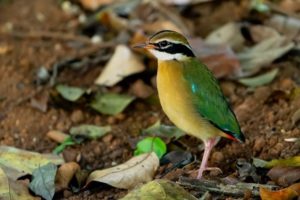
What a spectacular two-week tour this proved to have been! Because of the trip participants’ preferences we made this a photographically-paced tour and therefore missed some sites that would have padded our list a lot with widespread shorebirds etc. that didn’t interest us, since this was effectively a private tour. While this annual January set-departure tour is not a photography tour, all participants on this particular one were actually bird photographers, so we transformed it into a birding photo tour to some extent.
Please see the downloadable PDF above with the full species lists included.
